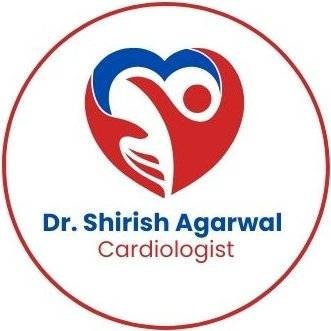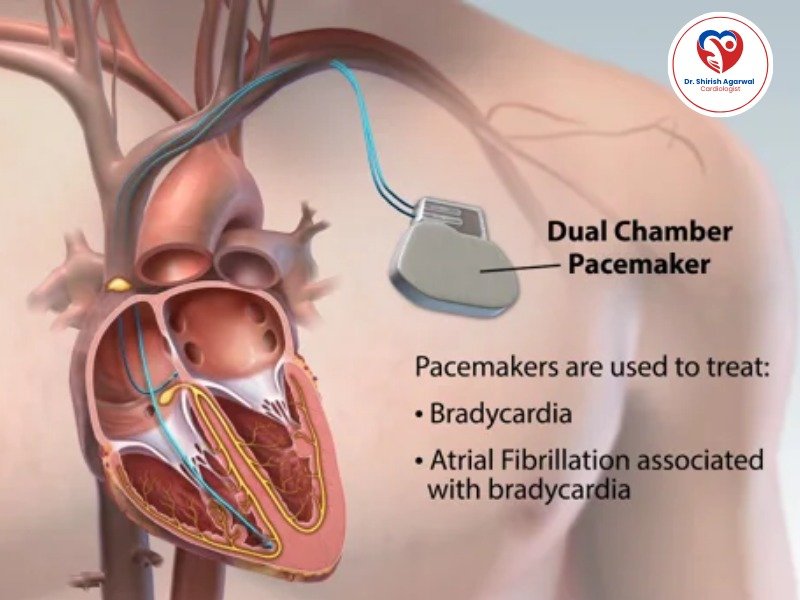Dual Chamber Pacemakers: An Innovative Cardiac Treatment
In the realm of cardiac care, technology continues to advance, offering patients more effective solutions for heart rhythm disorders. One such breakthrough is the dual chamber pacemaker, a device that significantly improves the quality of life for those with certain types of heart conditions. Here, we delve into the workings and benefits of dual chamber pacemakers, with insights from Dr. Shirish Agarwal, the best cardiologist in Indore.
Understanding Dual Chamber Pacemakers
A dual chamber pacemaker is a sophisticated medical device designed to regulate the heart’s rhythm. Unlike single chamber pacemakers, which stimulate only one chamber of the heart (typically the right ventricle), dual chamber pacemakers have two leads. One lead is placed in the right atrium, and the other in the right ventricle. This allows the device to coordinate the timing of contractions between these two chambers, closely mimicking the natural pacing of the heart.
How Dual Chamber Pacemakers Work
The dual chamber pacemaker continuously monitors the heart’s electrical activity. When it detects an abnormal rhythm, it sends electrical impulses to either or both chambers to maintain a normal heartbeat. This dual stimulation helps ensure that the atria and ventricles work in synchrony, promoting efficient blood flow throughout the body.
Advantages of Dual Chamber Pacemakers
Improved Synchrony: By pacing both the atrium and ventricle, dual chamber pacemakers provide better coordination of the heart’s pumping action, improving overall cardiac function.
Enhanced Quality of Life: Patients often experience fewer symptoms such as dizziness, fatigue, and shortness of breath, which are common with heart rhythm disorders.
Reduced Risk of Complications: Coordinating the atrial and ventricular contractions reduces the risk of atrial fibrillation, a common complication in patients with heart rhythm problems.
Adaptability: Dual chamber pacemakers can be adjusted to the patient’s specific needs, providing tailored therapy that evolves with the patient’s condition.
Dr. Shirish Agarwal, the best cardiologist in Indore, emphasizes that the benefits of dual chamber pacemakers go beyond my symptom relief. “These devices can significantly improve a patient’s ability to engage in daily activities, enhancing their overall quality of life,” he explains.
Conditions Treated with Dual Chamber Pacemakers
Dual chamber pacemakers are particularly beneficial for patients with certain types of heart block and bradycardia (slow heart rate). Here are some conditions where they are most effective:
Atrioventricular (AV) Block: This occurs when the electrical signals between the atria and ventricles are impaired. A dual chamber pacemaker ensures that the ventricles contract in response to atrial signals, maintaining a regular rhythm.
Sick Sinus Syndrome: This condition involves a malfunction of the heart’s natural pacemaker (the sinoatrial node). The dual chamber device helps regulate the timing of atrial and ventricular contractions.
Chronotropic Incompetence: This is the inability of the heart to regulate its rate appropriately in response to physical activity. A dual chamber pacemaker can adjust the heart rate to meet the body’s demands.
The Implantation Procedure:
The implantation of a dual chamber pacemaker is a minimally invasive procedure performed under local anesthesia. Here’s a brief overview:
Preparation: The patient is given a local anesthetic to numb the area where the pacemaker will be implanted.
Insertion: The cardiologist makes a small incision near the collarbone and inserts the leads into the veins, guiding them to the heart.
Placement: The leads are placed in the right atrium and right ventricle, and then connected to the pacemaker device, which is positioned under the skin.
Testing: The device is tested to ensure it functions correctly, and the incision is closed.
According to Dr. Shirish Agarwal, the best cardiologist in Indore, the procedure typically takes about one to two hours, and most patients can go home the same day or the next.
Post-Implantation Care
After the procedure, patients are advised to avoid strenuous activities for a few weeks to allow the incision site to heal properly. Regular follow-up appointments are essential to monitor the pacemaker’s function and adjust settings as needed.
Dr. Shirish Agarwal stresses the importance of post-implantation care, saying, “Regular check-ups ensure the pacemaker is functioning optimally and allows us to make any necessary adjustments to provide the best possible outcomes for our patients.
Conclusion
Dual chamber pacemakers represent a significant advancement in the treatment of heart rhythm disorders, offering numerous benefits over single chamber devices. By providing synchronized pacing to both the atrium and ventricle, these devices help maintain a more natural heart rhythm, improving patients’ quality of life and reducing the risk of complications.
For those considering a dual chamber pacemaker, consulting with a skilled and experienced cardiologist is crucial. Dr. Shirish Agarwal, the best cardiologist in Indore, brings unparalleled expertise in cardiac care, ensuring that patients receive the most effective and personalized treatment for their heart conditions. If you or a loved one is experiencing heart rhythm issues, don’t hesitate to reach out to Dr. Shirish Agarwal for expert guidance and care.

